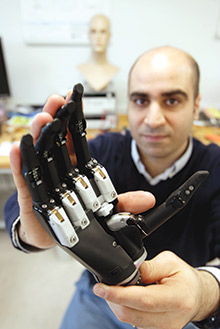
Kianoush Nazarpour, PhD, with the Newcastle University School of Electrical & Electronic Engineering, is leading a team to develop a bionic hand that connects to the forearm neural networks to allow two-way communications with the brain.
Photograph courtesy of Newcastle University.
The Engineering and Physical Sciences Research Council (EPSRC), which is the United Kingdom’s main agency for funding research in engineering and the physical sciences, has awarded £5.3 million (about US $8.2 million) to a collective of universities to fund the development of assistive devices for people with disabilities. The work, which will begin this spring, is being led by three English universities-Newcastle University, Newcastle upon Tyne; the University of Bristol; and the University of Warwick, Coventry-working with 15 other university partners. The three projects are a prosthetic hand that provides sensory feedback to the user, wearable soft robotics, and biosensors, as follows:
Enabling Technologies for Sensory Feedback in Next-Generation Assistive Devices; awarded £1.4 million (about US $2.2 million). The Newcastle-led team will develop a prosthetic hand that will give users a sense of feedback. The team will build fingertip sensors to give the prosthesis a realistic sense of touch, including pressure, shear, and temperature. In addition, a “virtual hand” will provide information about the hand’s position and movement. Finally, the system will translate the signals to a form the brain understands and stimulate the nervous system to help the user control the hand.
Wearable Soft Robotics for Independent Living; awarded £2 million (about US $3.1 million). The University of Bristol-led team will develop soft robotic clothing that is easy to use, comfortable, adaptable, and personalized to enable those with mobility impairments, disabilities, and age-related weakness to move easily and unaided and to live independently. This intelligent clothing will use artificial muscles made from smart materials and reactive polymers that are capable of exerting great forces. This will be developed using the latest wearable soft robotic, nanoscience, 3D fabrication, functional electrical stimulation, and full-body monitoring technologies, all driven by the need of the end users, who will also be directly involved in the project. Control systems that monitor the wearer and adapt to give the most suitable assistance and work with the body’s own muscles will be included in the design.
Adaptive, Assistive Rehabilitative Technology: Beyond the Clinic; awarded £1.86 million (about US $2.9 million). The University of Warwick-led team will design and develop inexpensive, disposable, unobtrusive biosensors, such as temporary tattoos and smart watches, to use with patients who use wheelchairs or prostheses, patients requiring rehabilitation, and older people. The study will collect data and monitor how patients use equipment provided to them, and also measure how they follow exercise advice at home, for example, after a stroke or accident. The research will also develop software that uses the biosensor information to support users with their equipment or exercises in their own home. The information will benefit patients and enable them to leave the hospital sooner and enable clinicians and medical technologists to understand conditions, better support patients in their home environment, and improve or adjust the design of equipment for patients.




